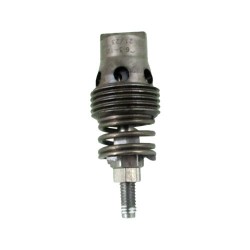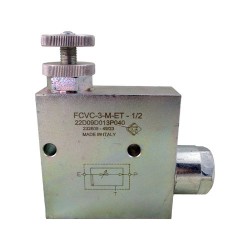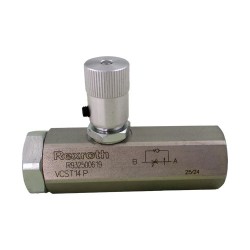Hydraulic flow regulator The hydraulic flow regulator is a key component in any hydraulic circuit. Its role is to control and stabilize the oil flow sent to a cylinder or motor, ensuring smooth and safe operation. From agricultural machinery and construction equipment to industrial systems and hydraulic power units, flow regulators are essential...
Hydraulic flow regulator
The hydraulic flow regulator is a key component in any hydraulic circuit. Its role is to control and stabilize the oil flow sent to a cylinder or motor, ensuring smooth and safe operation. From agricultural machinery and construction equipment to industrial systems and hydraulic power units, flow regulators are essential for protecting pumps, cylinders, and the entire hydraulic piping system.
What is a hydraulic flow regulator?
A hydraulic flow regulator functions as a control valve. Under normal conditions, it maintains a constant flow rate even when pressure fluctuates. This stability prevents jerky movements, extends the life of hydraulic components, and improves system safety. For maintenance technicians, it is a guarantee of reliability and performance in everyday operations.
The different types of flow regulators
2-way hydraulic flow regulator
The 2-way regulator is installed directly on a hydraulic line. It limits and stabilizes flow in one direction, making it ideal for controlling the speed of a hydraulic cylinder. It is the most common type for simple circuits.
3-way hydraulic flow regulator
The 3-way regulator has an additional port that returns excess oil to the tank. This design ensures better circuit stability, protects the pump, and maintains balanced pressure. Technicians value it for its precision and enhanced safety in demanding applications.
Mounting options
Flow regulators are available in several formats: inline mounting, easy to install directly on hydraulic piping; cartridge mounting, inserted into a hydraulic block for compact integration; and insert mounting, commonly used in multifunction blocks. Each solution fits different design or maintenance requirements.
Key technical specifications
Before selecting a hydraulic flow regulator, several technical criteria should be considered:
- Flow range: from a few liters per minute to more than 100 L/min depending on the model.
- Maximum pressure: most models withstand between 250 and 350 bar.
- Thread types: standard BSP threads 1/8, 1/4, 3/8, 1/2, 3/4 for easy connection to hydraulic piping.
- Operating temperature: typically –30 °C to +120 °C for mobile or industrial use.
- Flow adjustment: screw or locknut (Nylstop) for precise, stable setting.
- Oil filtration: critical to maintain accuracy and extend regulator service life.
Trusted brands: Bosch Rexroth and Oil Control
OCGF offers hydraulic flow regulators from leading manufacturers such as Bosch Rexroth and Oil Control. These brands are recognized worldwide for their superior build quality, precise tolerances, and proven durability in demanding environments. For maintenance technicians, this means fewer unplanned interventions and greater hydraulic performance. For industrial buyers, it ensures a reliable long-term investment.
Industrial applications
Hydraulic flow regulators are widely used across many sectors:
- Hydraulic cylinders: precise speed control for extension and retraction.
- Hydraulic pumps: protection against overpressure and excessive flow.
- Agricultural machinery: tractors, trailers, auxiliary distributors.
- Industrial machines: presses, conveyors, production lines.
- Construction equipment: cranes, aerial platforms, dump trucks.
- Specific systems: hatch opening systems or other mobile equipment requiring controlled motion.
Installation and maintenance
Installing a flow regulator is straightforward but must follow certain rules. The technician must select the right mounting type (inline, cartridge, insert), ensure thread compatibility, and respect the flow direction indicated by the manufacturer. After installation, flow should be adjusted gradually while monitoring cylinder or motor behavior. For maintenance, regular checks of flow stability, seal integrity, and oil cleanliness are essential. A high-quality filtration system is the key to extending service life and ensuring consistent performance.
How to choose the right hydraulic flow regulator?
Choosing the right model depends on circuit type, service pressure, required flow rate, and desired mounting format. Thread size must match existing piping. For intensive applications, premium brands like Bosch Rexroth or Oil Control are recommended to guarantee safety and reliability.
FAQ – Hydraulic flow regulator
What is the difference between a 2-way and a 3-way flow regulator?
A 2-way regulator controls flow in a single line, while a 3-way regulator returns excess oil to the tank, offering improved stability and safety.
How to adjust a hydraulic flow regulator?
Adjustment is made using a screw or locknut (often Nylstop), allowing precise control of oil flow and stable cylinder speed.
Can a regulator be installed on an existing circuit?
Yes, inline regulators are designed for easy integration into existing hydraulic piping, with a wide choice of thread sizes available.
What is the average service life of a flow regulator?
With clean oil and proper filtration, flow regulators have a very long lifespan. Regular maintenance checks help maximize durability.
Order your hydraulic flow regulators from OCGF
OCGF offers a complete range of hydraulic flow regulators: 2-way and 3-way models, inline, cartridge, or insert mounting, with various BSP thread sizes. All products are in stock, ready for fast delivery, and backed by our technical support. Choose our trusted brands such as Bosch Rexroth and Oil Control to ensure safety, performance, and long-lasting reliability in your hydraulic systems.









